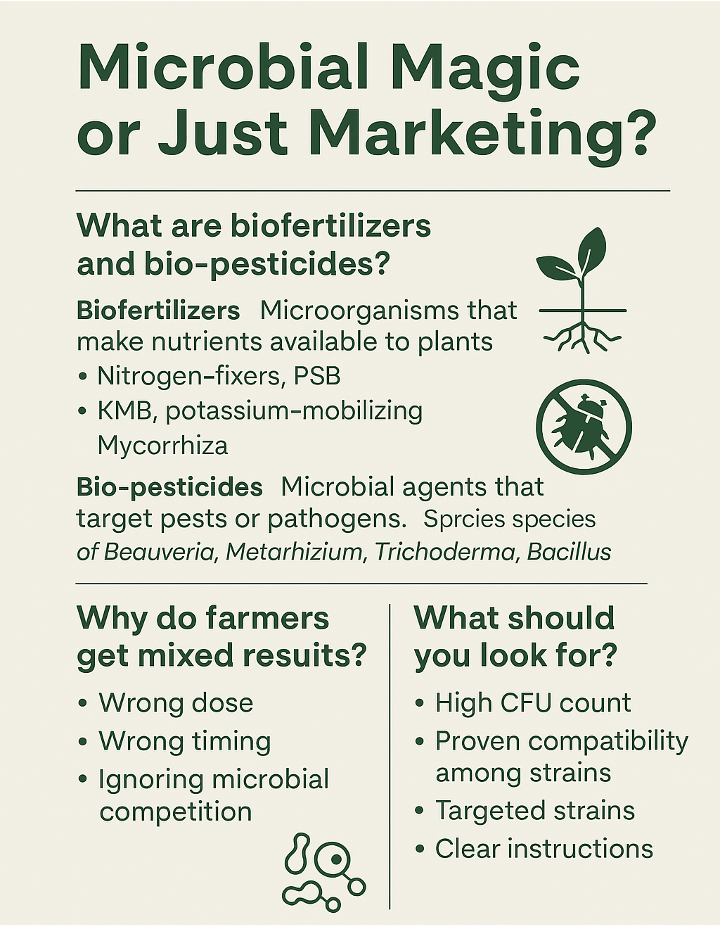
It seems every second agri input these days is “bio-something.” Biofertilizer. Bio-pesticide. Microbial consortia. It sounds fancy, but let’s be clear—this isn’t some new miracle. Microbes have been quietly running the soil system long before we built tractors.
What’s new is our attempt to bring the right ones back into the picture—because our current soil and pest management practices have disrupted the original balance.
So here’s the blunt truth:
Microbial products can work brilliantly—but only if used correctly, with the right expectations.
These are not fertilizers in the traditional sense (they don’t “add” nutrients). Instead, they unlock what’s already there.
Nitrogen-Fixers like Azospirillum, Azotobacter, or Rhizobium convert atmospheric nitrogen into plant-usable forms.
Phosphate-Solubilizing Bacteria (PSB) release locked-up phosphorus in the soil.
Potassium-Mobilizing Bacteria (KMB) do the same for potassium.
Zinc Mobilizing Bacteria (ZMB) do the same for Zinc.
Mycorrhiza connects directly with plant roots, extending their reach to access nutrients and water.
There are many other biofertilizers for other elements as well. As we learn more about them, we are sure to discover more.
Think of them as middlemen: they don’t create wealth (nutrients), but they know where it’s hidden and how to retrieve it. Additionally, as they die, they help with improving the Soil Organic Carbon.
These are microbial agents that attack pests or pathogens directly. Here are a few examples.
Beauveria bassiana and Metarhizium anisopliae infect and kill insects.
Trichoderma outcompetes or destroys fungal pathogens in the soil.
Bacillus thuringiensis (Bt) targets caterpillars and larvae.
These act like snipers—very specific, very effective, but only when deployed at the right time.
You’ve probably heard stories like:
“Worked great in nursery, but not in the field.”
“One season it showed results, next time it didn’t.”
“Same product, two plots, different outcomes.”
Let’s not sugar-coat it. This happens. And here’s why:
Using a few grams or ml assuming “kuch toh hoga” won’t work. These are live organisms. To colonize soil or leaves, they must outnumber what’s already there. That means billions of CFU (colony-forming units) per acre.
Applying microbes when the soil is bone dry, too hot, or just before a chemical pesticide—waste of money. They need friendly conditions to survive and multiply.
The moment you apply a microbe into soil, it’s entering a warzone. Other microbes may help it, ignore it, or kill it off. That’s why lab-tested formulations might fail in real soil if this isn’t considered.
Your soil is already home to billions of organisms. When you add new microbes, they must not only survive—they must thrive.
Lesson 1: In the soil, space and food are limited. Only the fittest microbes will establish themselves.
Lesson 2: Some microbes are friendly co-workers (synergists), others fight for the same resources (antagonists). A smart formulation avoids clashes.
Lesson 3: Antagonism seen in lab (petri dish) often doesn’t play out the same in field conditions. Soil is a three-dimensional, buffered, dynamic system. Trichoderma may dominate in a lab, but in real soil with organic matter, root zones, and moisture variation, others can hold their ground.
We get this question all the time.
If you know exactly what your crop needs (say, Rhizobium for legumes), then go for a single, targeted strain.
If you’re unsure, or soil conditions are variable, use a well-designed consortia—a blend of compatible microbes with multiple functions.
Just like a cricket team—don’t rely on just one star player. You need a balanced team with backup options.
High CFU count (e.g., 10⁷ or 10⁸ per gram or ml)
Strains that are crop-relevant and soil-adapted. Proven compatibility among strains (no in-fighting!)
Secondary metabolites ( released by microbes produce multiplication ). Much of it also depends on the substrate or media used and the quality of fermentation.
Carrier material. For example good carbon carrier gives great space for microbes to survive. Some other active substrates can help with pH buffering etc. They can impact the final outcome.
Microbial inputs are tools, not magic potions. Use them with understanding.
Know your field. Moisture, organic matter, and soil pH all impact success.
Use proper dose, and always apply under favorable conditions.
When in doubt, choose tested, balanced consortia over untested mixtures.
Don’t chase exotic names—go with what’s field-tested and locally relevant.
Next Up in the Series:
In Blog 2, we’ll tackle how to calculate correct doses of microbial inputs—both for soil and foliar applications—and what happens when you get the math wrong.
Because like microbes, numbers matter.
There was this interesting discussion I had with Mr Prateek
The teaser of Self Running Soil Revolution for an investment
The effectiveness of any microbial product depends not just on
Mitrasena (Army of friends) is global brand of Biowall Agrihealth Pvt Ltd. Mitrasena products & protocols enables seamless transition to non-toxic farming by concurrently offering Excellent Protection, Higher Productivity & Profit and, Ease of use.
We are a DIPP recognized Startup working for non-toxic crop protection. We are driven by a highly passionate and professionally competent team.
MitraSena © 2025 | All rights reserved | Innovatively Designed and Built by Social Mukul Media
Have any query about bulk orders? Get in touch with us.